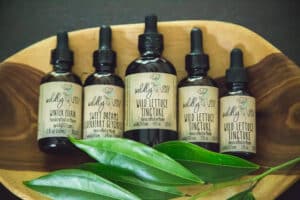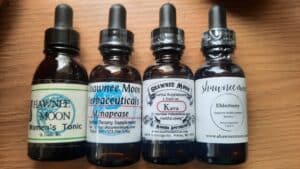4 of My Favorite Herbs to Grow

Today I thought I’d write about a few of my favorite herbs to grow. Why and how and perhaps some tips you may or may not have known on care and harvesting.
Basil – This is very much my favorite herb to grow, probably because I absolutely love the taste and scent and love cooking with it fresh. It is also super easy to take care of. It tends to like hot sunny spots, but consistent watering with good drainage. They don’t like their feet wet.
I try to grow 2-4 individual plants, or more, if I can. I love adding it to floral arrangements as well if I have extra. The broad, glossy leaves look great in a vase with zinnias, marigolds and other flowers from the garden.
I love chopping fresh basil with raw garlic and sauteing it in a skillet with olive oil til the garlic begins to brown. Then I mix in about ½ cup of parmesan cheese and toss with pasta. My mouth is watering just thinking about that. We also like making ‘margarita’ pizza, with red onion slices, fresh tomato slices, garlic and whole basil leaves.
As a medicinal plant, the scent is said to help with memory and focus, it is also supposed to support healthy thyroid function. Harvest basil leaves all through the growing season before it blooms. Basil is a tender annual, meaning once the first frost hits, it will die and be done. If you are forecast a frost, harvest all the remaining plants, stems and all, cut back to the ground and tie up in bunches to hang and dry.
TIP: Pinch back the buds as they form before they bloom. This will encourage more leaf production as the plant is not putting energy out to produce seeds.
Though I have never grown it inside, I do believe Basil would be an easy herb to grow in a pot during the winter months. I would just make sure it was in a very warm spot. Typically, a window sill is too cold during the winter. Make sure it is near light as much light as possible, but also staying considerably warm.
Basil can be started straight in the ground or in your garden (after danger of frost) by seed and as seedlings start, it is a good idea to divide (or thin) them so they have more room to grow. But in a large pot, 8”-12” you could pack in a good 3-4 plants if you need the space.
Sage – Sage is a perennial, meaning it comes back every year. I have never grown it from seed, always planted plants from the nursery, and always been happy at how easy it seems to be to take care of. I think it also prefers hot, dry climates, with well drained soil, but I’ve also seen it do fairly well is quite damp, rich/clay soil, too. This is another one I love having fresh cause I love cooking with it. I do the exact same process I mentioned above sauteing it with garlic and olive oil then add parmesan and tossing it over pasta… oh it’s SO good!!! One of my favorites!

I don’t usually harvest a lot to store of Sage, because to me, the flavor fresh is just so good, I don’t bother with it dry. When I do harvest, I just clip back some of the larger but tender leaves from multiple stalks, so that each stalk continues to grow leaves. I’ve had sage plants last for years and years and then all at once dye off. I’ve had ones that bloom every year, and others that don’t seem to bloom. I really should probably research more about sage and it’s life cycle, but I haven’t. I’ve not had to replace my plants too often, so I count that as a win and just buy another if I happen to lose one. There also are probably some specific pruning suggestions as it is a woody almost-evergreen bush, but I am not aware of any. (do let me know if you have some Sage advice) yes, that pun was intended.
I don’t usually harvest after the bush has bloomed. I have harvested the blooming spikes and leaves to add to fresh flower bouquets.
Cilantro – I do love growing this herb and while it is pretty easy to start from seed in the ground after danger of frost, it can be quite frustrating. The reason being, is it doesn’t seem to have a very long growing season, about the time it gets leaves on it big enough to consider harvesting for making a good batch of fresh guacamole, it ‘bolts’ and is spent.

Bolting means, the plant quickly flowers and goes to seed. This is typical more of cool weather crops, once you get a few good hot days, the plant just grows like mad and goes to seed and this can change the taste of the produce, and result in no more harvesting to be had.
If you are very attentive, you can help slow this process by staying on top of any flower buds forming. Pinch them back immediately and often. It is only frustrating to me because I guess I’m just not on top of it enough and I miss out on harvesting cilantro as much as I could have. But some years I just don’t have the time.
Besides those grievances, I do love the scent and flavor of cilantro. And, actually, a plus to the fact that they bolt easily, is they can also self-seed. Meaning, they can drop their seed and actually produce more plants the following spring if they happen to germinate. So that’s food for free. I do try to collect seed once it’s matured and dry it, saving it to replant for the next season.
We love making fresh guacamole with cilantro and home grown garlic, onions and tomatoes. It is usually a short season, but for sure worth the trouble for the fresh taste.
Garlic – This has always been a satisfying herb to grow, as it takes minimal effort and it is awesome to watch grow and harvesting is quick and easy. Although it does take some forethought to plan ahead if you want to grow garlic in your garden.

In late fall after the first frost, you will plant individual garlic cloves in your prepared garden bed. I plant in a different bed every fall, and plant in fairly close rows. Cover with a few inches of dirt, and I like to mulch heavily with leaves that are typically plentiful in October/November, and wait. Through the winter, if we have some warmer days like we have had this winter, the garlic can sprout before it should. I just raked up more leaves in a heap to protect them a bit more from frost, snow and ice. But in general they will be fine and survive through to still produce in spring/summer. Just don’t let your bed get waterlogged.
As the weather starts to stay consistently warmer and spring comes on strong, the garlic cloves will send up green shoots that look like green onions. Once all danger of frost is away, I might pull back some of the mulch from the soil, but leaving some to suppress weeds. I don’t water them much, if at all, especially during the spring showers we typically get here; just keep weeded and leave them alone.
Later in the summer, if they start developing flower buds, I pop the flowers off so more energy is spent on growing the garlic bulb and not flowers/seeds.
Once the greens start dying and turning yellow, this is when they are ready for harvest. I’ve recently heard a tip that if it’s not supposed to rain for the next few days, that when you harvest (simply by pulling them out of the ground by the stem; carefully using a spade or fork if your ground is too dry or compacted), then you leave them to lay on the soil for a few days or even a week (again, as long as weather permits). This is supposed to help cure them, and then you bring them in to clean up and lay out in a warm, dry space to finish drying out before storing them in a cool dry place.
Garlic has so many valuable uses since is is considered antiviral, antifungal and antibacterial. We love using it all year round in nearly any and every dish, from fresh guacamole to homemade chicken veggie soup. We like it to support our immune systems and just provide an overall feeling of well-being.
There are many types of garlic to grow, if you want to make those beautiful garlic braids you may have seen, make sure you get a ‘soft neck’ garlic, as they will work for braiding where as ‘hard neck’ garlic will not!
As you can tell from my personal descriptions, I love growing these herbs more for their culinary uses rather than their medicinal uses. Most of the herbs that I grow that I use fresh medicinally, are actually native wild edibles that I just more or less ‘let’ grow in the garden. Lots of plants that most people would pull as weeds, I like to leave some to have on hand for first aid. Maybe I’ll write another post about them.
What is your favorite herb to grow?





